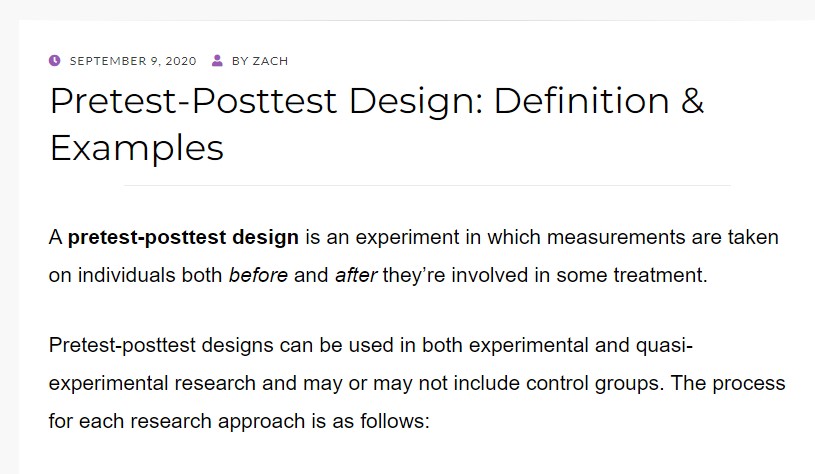Study designs: Part 4 Interventional studies PMC
Table Of Content

For this purpose, we added the standard deviation of pre-post differences, multiplied by the corresponding value of δexp, to each individual Y1 value. Our second goal was to promote the use of individual-based statistics as a simple and useful tool for addressing important research questions. Based on our simulation results, we show that such statistics can be used to interpret research results and make decisions in applied settings.
An Introduction to the Exponential Distribution
I created this website to help researchers conduct studies from concept to publication. Introduction to Statistics is our premier online video course that teaches you all of the topics covered in introductory statistics. Statology is a site that makes learning statistics easy by explaining topics in simple and straightforward ways. Our team of writers have over 40 years of experience in the fields of Machine Learning, AI and Statistics.

How to Use n() Function in R (With Examples)
You have collected their individual anxiety scores and coded them so you can compare the posttest for each participant; I'll explain this a little more in a minute. You perform the therapy with each participant and then give them the posttest. Remember, a pretest-posttest design is to examine and demonstrate if the experimental manipulation causes a change.
California Baptist University
Initially, seventy-six participants completed a questionnaire as part of the pre-test phase, subsequently invited to engage with all four VP cases, and finally responded to the post-test questionnaire evaluating clinical reasoning skills. Fifty-six participants successfully completed the entire study process and were considered in the analysis. The primary outcomes of this study were evaluated using a paired t-test for the statistical analysis. Pre-post designs are often used when an intervention is applied between the two time points. Like the pre-post design, a post-only design can include multiple post-tests to create post-post designs that take measurements throughout the intervention or after it finishes. The difference is whether the first test is at the start of the study or after the intervention has already begun.
Policy, clinical and research implications of our findings
The only basis of deriving a conclusion from these studies is the temporal relationship of the measurements to the intervention. However, the outcome can instead be related to other changes that occurred around the same time as the intervention, e.g., change in diet or implementation of alcohol use restrictions, respectively, in the above examples. The change can also represent a natural variation (e.g., diurnal or seasonal) in the variable of interest or a change in the instrument used to measure it. Thus, the outcomes observed in such studies cannot be reliably attributed to the specific intervention, making this a weaker design than RCT.
Table 3
Some additional methodological features are often added to this study design to further improve the validity of a trial. These include allocation concealment, blinding, intention-to-treat analysis, measurement of compliance, minimizing the dropouts, and ensuring appropriate sample size. The use of randomization is a major distinguishing feature and strength of this study design. A well-implemented randomization procedure is expected to result in two groups that are comparable overall, when both measured and unmeasured factors are taken into account. Thus, theoretically, the two groups differ only in the intervention received, and any difference in outcomes between them is thus related to the effect of intervention. In the fourth piece of this series on research study designs, we look at interventional studies (clinical trials).
These types of studies are well-suited to settings where there is routine enumeration of a cohort based on a specific eligibility criteria, such as enrolment in a health plan or employment group, or from a disease-based registry, such as for diabetes (27, 42). It has also been reported that this design can increase efficiency and statistical power in contrast to cluster-based trials, a crucial consideration when the number of participating individuals or groups is small (22). It can be useful to obtain pre-test data or baseline characteristics to improve the comparability of the two groups. In the most controlled situations within this design, the investigators might include elements of randomization or matching for individuals in the intervention or comparison site, to attempt to balance the covariate distribution. Implicit in this approach is the assumption that the greater the similarity between groups, the smaller the likelihood that confounding will threaten inferences of causality of effect for the intervention (33, 47). Thus, it is important to select this group or multiple groups with as much specificity as possible.
Effects of a work-related stress model based mental health promotion program on job stress, stress reactions and ... - BMC Public Health
Effects of a work-related stress model based mental health promotion program on job stress, stress reactions and ....
Posted: Wed, 04 Nov 2020 08:00:00 GMT [source]
There were approximately 288 design & applied arts students who graduated with this degree at FIDM Los Angeles in the most recent data year. Students who graduate with their degree from the design program state that they receive average early career wages of $27,983. Detailed reviews have been published of variations on the basic ITS design that can be used to enhance causal inference. In particular, the addition of a control group can be particularly useful for assessing for the presence of seasonal trends and other potential time-varying confounders (52). Zombre et al (52) maintained a large number of control number of sites during the extended study period and were able to look at variations in seasonal trends as well as clinic-level characteristics, such as workforce density and sustainability.

An Introduction to the Multinomial Distribution
If a study were comparing outcomes before and after a given intervention, but also between the treatment group and a control group, with patients randomized into groups, it would be an RCT, just with a temporal aspect included in the outcome assessments. In the presence of a control group, Pre-Post test designs have a strong internal validity but face challenges in achieving external validity (Shuttleworth, 2009). However, when done in a non-experimental setting, since there is no baseline measurement against groups that remained completely untreated, it becomes challenging to find whether the pre-testing process influenced the results (Shuttleworth, 2009), thus weakening internal validity. For example, children giving a pre-test may try a harder in their lectures and try to outperform children who were not given a pre-test; thus making the test results an outcome of the experimental process, rather than administering the treatment alone (Shuttleworth, 2009). Our study demonstrated that it is feasible to conduct a health education intervention on SCD and NBS among pregnant women within the community setting. It also provided evidence that pregnancy presents an ideal period for health education on SCD and NBS as increased overall level of knowledge and improvement in specific knowledge questions were noted.
Degree recipients from the design & applied arts major at Otis College of Art and Design make $6,481 above the typical college grad in this field when they enter the workforce. There were approximately 228 design & applied arts students who graduated with this degree at UC Davis in the most recent data year. Degree recipients from the design & applied arts major at University of California - Davis make $6,024 above the typical graduate in this field shortly after graduation. The Best Colleges for Design majors ranking is based on key statistics and student reviews using data from the U.S.
Pre-post designs are fit for evaluating interventions or treatments implemented in real-world settings. They provide insights into the effectiveness of these interventions in everyday practice, reflecting the outcomes occurring outside of the controlled research environment typical of RCTs. The real-world practice context can help researchers understand the potential limitations, challenges, and benefits of the intervention when applied in the wider population. This pilot study demonstrates that focused health education among pregnant women has a positive effect on their knowledge of SCD and NBS. Regular conduct of such educational programs has the potential to dispel any cultural myths and practices surrounding SCD and NBS. Results from this pilot study will ultimately guide the development of a large-scale community-based intervention to address the research and program gaps for SCD newborn screening in Nigeria.
Comments
Post a Comment